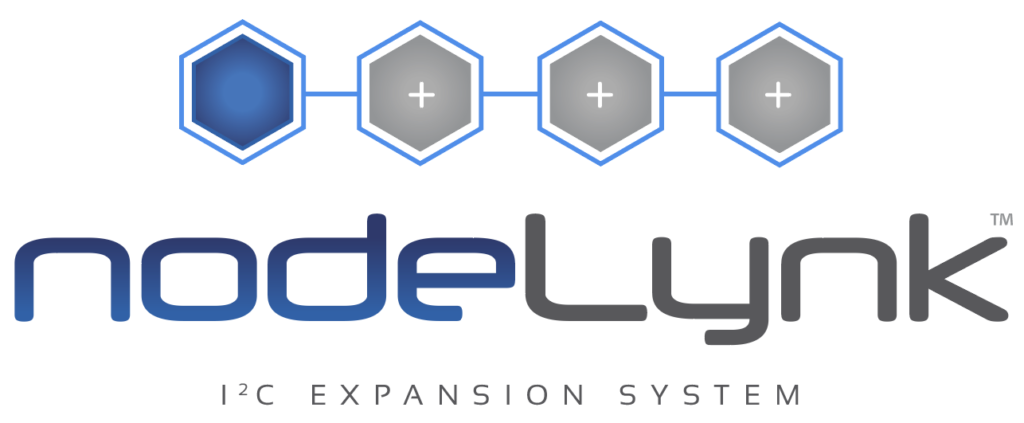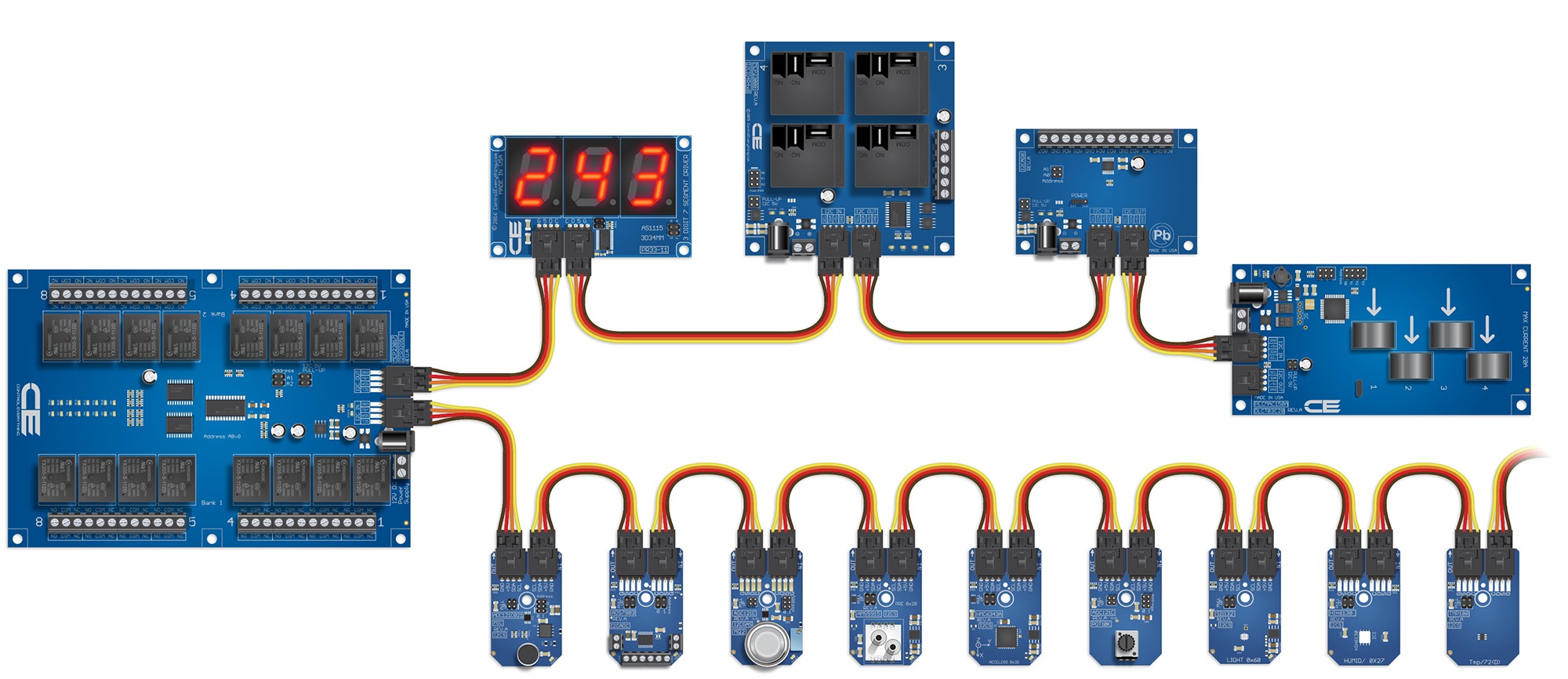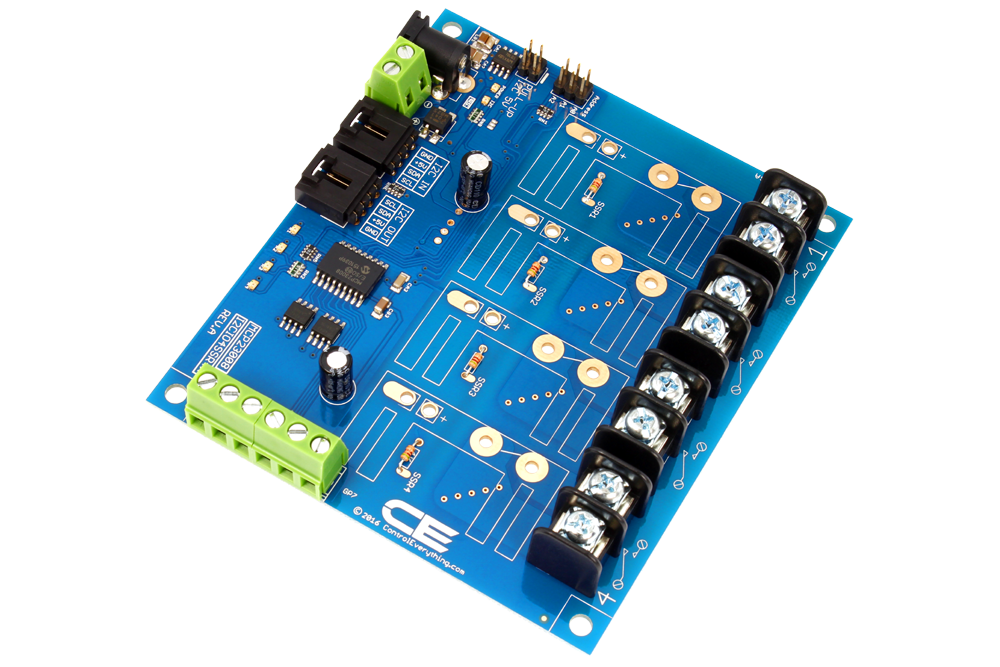4-Channel Solid State Relay Controller + 4 GPIO with I2C Interface
Highlights
- 4-Channel SPST Solid-State Relay Controller with I2C Interface
- 4-Channel Programmable Digital Input/Output
- Ideal for use with PC using Windows 8/10 via USB
- ESP8266 and USB I2C Interface Modules are Also Available
- Compatible with Arduino, Raspberry Pi, Onion, PyCom
- Control Solid-State Relays using IoT Communication Modules
- MCP23008 I2C Controlled Solid-State SPST Relays
- Hosts up to 4 Solid-State Relays (Optional Accessory)
- I2C Output Port for Adding Sensors, Controllers, or More Relays
- Wireless Remote Operation with Key Fob Expansion Option
- Use the Arduino Wire Language to Control On-Board SSRs
- Example Libraries Available on GitHub
This I2C 4-channel Solid-State relay controller offers a cross-platform solution with unmatched compatibility and expansion capabilities. Compatible with every IoT technology that supports I2C communications, this is the most versatile relay controller we have ever manufactured. All NCD I2C relay controllers have a I2C output, allowing you to chain together more relay controllers, a vast array of sensors, current monitors, PWM drivers, and much more. The expansion abilities of this relay board are unmatched by any other manufacturer in the world. This controller is based on the MCP23008, a common I2C interface chip for GPIO applications. In this design, the GPIO port is used to control 4 solid state relays. Four programmable Digital Input/Output port pins are also available via screw terminals for use in Contact Closure detection applications or monitor and control external TTL circuits. Three on-board address jumpers allow up to 8 similar devices (based on the MCP23008 or MCP23017) to be chained to the same I2C bus for individual control. On-board status LEDs display the on/off status of each relay. This controller may be powered using our optional power supply or with 12VDC and direct screw terminal connection of bare power wires. Each solid state relay is accessible to the user via two large screw terminals, capable of accepting 12 AWG wire. This controller includes many solid-state relay options, customized when added to your shopping cart.

nodeLynk™ Device
This is a nodeLynk device, it will require a nodeLynk Master Adapter for proper operation. nodeLynk devices plug into Master microprocessors to easily add hardware sensing and control capabilities.
What is nodeLynk?
Chain expansion devices using nodeLynk. Connect a wide variety of accessories to expand the capabilities of a nodeLynk compatible controller. Use nodeLynk to add Relay Controllers, Sensors, PWM Drivers, Displays, and a wide variety of 4-20mA, 0-10V ADCs and DACs, as well as a wide array of TTL & Isolated GPIO devices. All nodeLynk devices use I2C communications to chain devices together. nodeLynk is an easy way to expand functionality without soldering. nodeLynk allows expansion in seconds so you can focus on your software and firmware development.

What is the nodeLynk I2C Interface?
NCD is the creator of plug and play modular hardware using nodeLynk, which is hardware I2C Interface connector standard. nodeLynk I2C devices allow you to chain together several devices on the I2C bus, and communicate to each device individually at high speed (subject to the limitations of I2C). The nodeLynk I2C Interface uses a standard 4-Pin I2C Input and I2C Output connector. nodeLynk I2C devices communicate 5V I2C data and provides 5V DC power through this connector. nodeLynk I2C devices use standard I2C communications for all data transport, which is supported by nearly every microcontroller in production today. The nodeLynk I2C Interface is strictly a 5V standard, which is ideal for transport across longer cables. nodeLynk I2C devices always include a 6″ (152mm) 4-conductor I2C cable. nodeLynk I2C Mini Modules always include a 3″ (76mm) 4-conductor I2C cable. Cables and connectors are available separately for designers who would like to include their own nodeLynk I2C Interface into their designs.
Plug and Play Connectivity
nodeLynk I2C devices will plug in to any available nodeLynk I2C Output. This includes just about everything we make in the NCD IoT Category, including all NCD IoT devices. We also manufacture a wide range of I2C adapters that make it easy to plug nodeLynk I2C Devices directly into most computing platforms. nodeLynk I2C Interface adapters are available for Arduino, Banana Pi, BeagleBone, Bluz, ESP8266, Onion Omega, Particle Photon and Electron, PyCom, Raspberry Pi, 2, 3, and Zero, and Windows. We are always working to add new platform support for nodeLynk I2C devices. nodeLynk I2C Interface devices are compatible with just about everything in the microcontroller industry.
Unlimited I2C Expansion
Based on our plug-and-play I2C interface standard, all nodeLynk I2C devices are equipped with a I2C output port, making it easy to expand to a wide variety of sensors, current monitors, relay controllers, PWM controllers, and much more! We are always designing new expansions for our modular plug-and-play I2C framework. We are dedicated to building a product line of interconnected devices to simplify all forms of automation. Re-use or upgrade your hardware in seconds by selecting the modules that best fit your needs, and chaining them together using the included I2C expansion cables!

A Raspberry Pi (above) is connected to a nodeLynk Master adapter. nodeLynk devices are chained to the Raspberry Pi nodeLynk Master using I2C communications. Each nodeLynk device must have a different I2C address for proper operation of the chain. Note that some nodeLynk I2C devices have a fixed address while others allow configuration of the address across a limited range of addresses.
Powering nodeLynk I2C Interface Devices
Some nodeLynk I2C devices require a external power supply, others may be powered through the 4-Pin I2C bus connector at 5VDC, and other devices are jumper selectable between external and I2C bus power. All I2C mini modules are powered through the 5V I2C bus connector, greatly simplifying connectivity.
Associated Part Numbers
This product may have been previously manufactured using a part number shown below:
Relay Options

Solid State Relays Option
Solid state relays are ideal for agricultural switching applications, or remotely located switching. SSRs are frequently chosen to control pumps, valves, solenoids, lights, and other high-reliability applications. NCD solid-state relay controllers do not include solid-state relays, but you will have the option to choose the type of solid state relays you require when customizing your product. This controller is designed specifically to fit select Crydom solid-state relays, but may be compatible other solid-state relays made by other companies. Review Solid-State Relay Options
Mechanical Drawing
Wiring Diagrams
Essential
Tutorials
Datasheets
Documentation Downloads
Community Repositories
Official Repository
Introduction to Relay Control
This video will guide you in determining which relay controller you need for your application as well as a general overview of the differences between Relay Options. If you’re new to our products or just need a refresher for a new application this is a great place to start.
Induction Suppression
Learn about Induction and how it comes into play with Relay Controllers. Induction suppression can make your Relay Control applications intermittent and unreliable. This video will show you what causes it, how to avoid it, and how to account for it in your application.
Integration Notes
Solid-State relays are quiet with a long operational life, and should be used in critical applications where reliability is of the most importance. Solid-State relays must be carefully chosen for your particular application. This controller hosts SPST Solid-State relays only, providing 2 connections to each relay: Common and Normally Open. When the relay switches on, the Common connection is connected to the Normally Open. External loads may be wired to be off all the time and turn on when the relay turns on. Relays are controlled using the MCP230xx Series Programmable GPIO Port Expanders from Microchip Technology. Relays are controlled by a MCP23008 using GPIO0:3, GPIO4:7 are available for user interface via screw terminals. Controlling on-board relays is easy: Set GPIO0:3 as Digital Outputs. Next, set the on/off status of GPIO0:3 to activate the corresponding relays. LEDs indicate the status of on-board relays. All of these operations are handled for you when using the drivers supplied in our GitHub repository (ControlEverythingCom). Induction suppression capacitors are strongly advised for inductive switching applications (anything that generates a magnetic field). Induction suppression capacitors will prolong the life of the relays and help prevent malfunctions when switching high voltages.
This controller applies a 12VDC voltage into the gate of a Solid-State relay through a 512 Ohm resistor. This controller is safe for relays rated with a maximum 10VDC gate voltage. This controller is generally used with relays that accept a voltage range of 3-12VDC gate voltage. Solid-State Relays are subject to MINIMUM load requirements. Extremely low signals may NOT be switched by Solid-State Relays if they do not meet the minimum load requirements.
Solid-State Relays are available for AC or DC switching applications, which are NOT interchangeable. AC relays may not be used to switch DC loads, similarly, DC relays may not be used to switch AC loads. DC RELAYS ARE POLARITY SENSITIVE, AND MAY BE DAMAGED IF IMPROPERLY CONNECTED. Because our Solid-State controllers may be used with relays from other manufacturers, we do NOT label the + and – connections for DC Solid-State Relays on the circuit board. Please examine the relay and the datasheet, follow the traces printed on the bottom of the circuit board to ensure correct polarity. Some Solid-State Relays may require active forced-air cooling. Failure to apply cooling may result in permanent damage of the relay.
Please examine the datasheet for the particular relay you are using BEFORE connecting.
WE DO NOT WARRANTY SOLID-STATE RELAYS UNDER ANY CIRCUMSTANCES.
I2C Interface Compatibility
NCD I2C Interface devices are designed to plug in to many popular IoT computing platforms. This allows the “brains” from other manufacturers to directly plug into our devices for easy plug-and-play operation. I2C interface devices use I²C as the underlying communications technology. The notes below will guide you into plugging 3rd party technologies into our devices, we will highlight any adapters that may be required in this section. Please note that all NCD I2C Interface Devices can be chained together to any other Cross-Platform I²C Slave Devices using the I²C Output. Additionally, NCD I2C devices may be plugged into the I2C Output of NCD IoT Interface devices. A complete list NCD I2C Interface adapters is available by clicking here.
Arduino Interface
- Plug this device into the Arduino Micro I2C Shield
- Plug this device into the Arduino Nano I2C Shield
- Plug this device into the Arduino Uno I2C Shield
- Plug this device into the Arduino Due I2C Shield
Banana Pi Interface
- Plug this device into the Banana Pi I2C Shield
BeagleBone Interface
- Plug this device into a BeagleBone I2C Shield
Bluz Bluetooth Interface
- Plug this device into the Bluz I2C Shield (with power)
C.H.I.P. Interface
- Plug this device into the C.H.I.P. I2C Shield
ESP8266 Interface
- Plug this device into the NodeMCU ESP8266 I2C Shield
- Plug this device into the Adafruit Huzzah ESP8266 I2C Shield
Particle Interface
- Plug this device into a Particle Photon WiFi I2C Shield
- Plug this device into a Particle Electron Cellular I2C Shield
Onion Omega 1 & 2 Interface
- Plug this device into a Onion Omega I2C Shield
PyCom Interface
- Plug this device into a PyCom WiPy, WiPy2, and LoPy I2C Shield
Raspberry Pi Interface
- Plug this device into a Raspberry Pi I²C Interface Adapter
- Plug this device into a Raspberry Pi 2/3 I²C Interface Adapter
- Plug this device into a Raspberry Pi Zero I²C Interface Adapter
Windows 8/10 PC USB Interface
- Plug this device into a USB to I2C Converter
- Plug this device into the BridgeX5 Series Controller
Choosing a Solid State Relay
Please examine the datasheet of each solid state relay carefully, as SSRs do not function exactly like mechanical switches. SSRs frequently have minimum load requirements, and some require external snubber circuitry for certain applications. SSRs do not typically work with volt meters in the same way as mechanical switches. SSRs must also be chosen for AC or DC applications, as they are not universally interchangeable. Some SSRs require forced air cooling, and may be damaged if not properly ventilated. Please consult the experts at Crydom.com if you are uncertain about your choice of SSR.






















